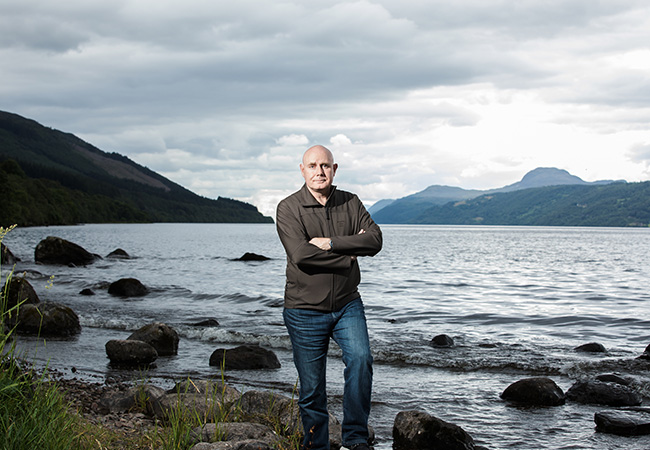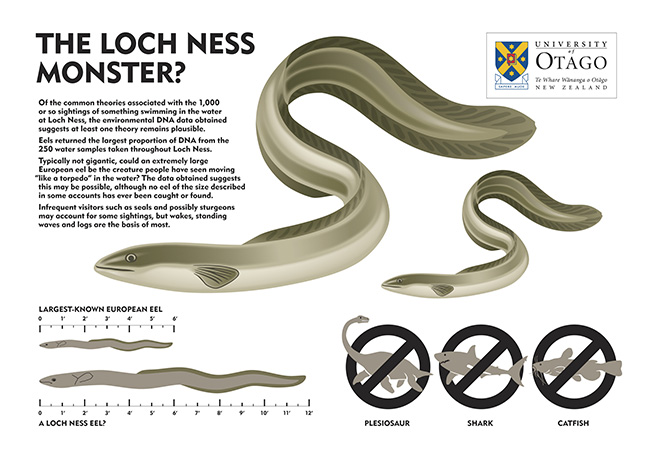
Dr. Neil Gemmell in new Loch Ness special on the Travel Channel.
University of Otago geneticist, Professor Neil Gemmell can today announce the results of investigations into the environmental DNA present in the British Isles largest and second deepest body of fresh water, Loch Ness.
The results come after 250 samples of water were taken around, through the centre, and into the very depths of Loch Ness. DNA from each sample was captured, extracted and sequenced then compared against global DNA databases to reveal a comprehensive picture of life present in the Loch – examining the bacteria, the fish, and everything else in between.
“Most species are so small you can barely see them but there are a few that are larger and of course the question we're all asking is - is there anything big enough to explain the sorts of observations people have made over the years that have led to this myth or this legend of a monster or creature in Loch Ness?” Professor Gemmell says.
The “monster-factor” has provided Professor Gemmell with an opportunity to showcase the science of eDNA to the world, and the project has subsequently drawn considerable interest.
In conjunction with this announcement, a documentary team from Travel Channel has been on the journey with Professor Gemmell and his team, with a two-hour special set to premiere in the United States on Travel Channel and in the UK on Discovery Channel on September 15.
“The search for Nessie is one of the world's most iconic and beloved mysteries, capturing our imaginations and sense of adventure,” says Matthew Butler, GM, Travel Channel. “This scientific expedition for answers to what could be lurking beneath those waters is extremely captivating viewing.”
“People love a mystery, we've used science to add another chapter to Loch Ness' mystique,” Professor Gemmell adds.
With over a thousand reported sightings dating back to the 6th century, Professor Gemmell says of all the ideas for what people have seen in the water, one of the more common, and outrageous, is there might be a Jurassic-age reptile or population of Jurassic-age reptiles such as a plesiosaur present in Loch Ness.
“We can't find any evidence of a creature that's remotely related to that in our environmental-DNA sequence data. So, sorry, I don't think the plesiosaur idea holds up based on the data that we have obtained,” Professor Gemmell says.
The research team tested other predominant theories of various giant fish; whether it be a giant catfish or a giant sturgeon, an eel, or even a shark such as a Greenland shark.
“So there's no shark DNA in Loch Ness based on our sampling. There is also no catfish DNA in Loch Ness based on our sampling. We can't find any evidence of sturgeon either,” Professor Gemmell says.
The remaining theory that Professor Gemmell cannot refute based on the environmental DNA data obtained is that what people are seeing is a very large eel.

“There is a very significant amount of eel DNA. Eels are very plentiful in Loch Ness, with eel DNA found at pretty much every location sampled – there are a lot of them. So - are they giant eels? Well, our data doesn't reveal their size, but the sheer quantity of the material says that we can't discount the possibility that there may be giant eels in Loch Ness. Therefore we can't discount the possibility that what people see and believe is the Loch Ness Monster might be a giant eel.”
Professor Gemmell adds that “further investigation is needed to confirm or refute the theory, so based on our data, giant eels remain a plausible idea.”
He notes that in 1933 researchers had also proposed that a giant eel might in fact be the explanation for some of the sightings made then. That idea then waned as notions of extinct reptiles became more prominent.
He notes other evidence such as the video shot by Mr Gordon Holmes in 2007 which shows a four metre torpedo-like shape seemingly swimming on the Loch's surface support the hypothesis of a giant eel, large fish, or perhaps a marine mammal.
“Divers have claimed that they've seen eels that are as thick as their legs in the loch, whether they're exaggerating or not - I don't know - but there is a possibility that there are very large eels present in the loch. Whether they are as big as around four metres as some of these sightings suggest – well, as a geneticist I think about mutations and natural variation a lot, and while an eel that big would be well outside the normal range, it seems not impossible that something could grow to such unusual size.”
Professor Gemmell is philosophical about the study findings, and believes no matter what science says, there will always be belief in the Loch Ness monster.
“What I'm most satisfied with is that we came here to study environmental DNA, and our analysis has captured everything we thought is in the loch. We now have an excellent database which if compared to any future testing could enable us to identify trends and changes in the Loch environment. That is essentially the benefit of eDNA – it is an extremely powerful and robust tool to document the living things (both large and microscopic) present in a given place. It's going to be extremely useful in the future as the technology becomes quicker and more accessible, more data is created.”
Professor Gemmell says one of the more intriguing findings was the strong input of DNA from land-based species in the Loch.
“We found substantial levels of DNA from humans and a variety of species directly associated with us such as dogs, sheep and cattle. However we also detected wild species local to the area such as deer, badgers, foxes, rabbits, voles and multiple bird species. These findings indicate eDNA surveys of major waterways may be useful for rapidly surveying biological diversity at a regional level.”
Professor Gemmell would like to acknowledge the significant support of Adrian and Marylyn Shine of the Loch Ness Project and the Loch Ness Centre and Exhibition, with access to facilities, boats, equipment and expertise during the course of our investigations. Colleagues at the University of Otago, University of Copenhagen, University of Highlands and Islands, University of Hull and the University of Bangor all contributed to the testing at Loch Ness last year. DNA was extracted at the University of Hull, processed for analysis at Université Grenoble Alpe and sequenced at Fasteris with the support of Illumina. Analyses were undertaken at Otago, Université Grenoble Alpes, University of Hull, John's Hopkins University and the University of Santa Cruz. Qingdao Huakai Ocean Science and Technology Co. Ltd supplied the rope that enabled the researchers to sample to the very depths of Loch Ness.
Visit the Loch Ness Project and the Loch Ness Centre and Exhibition websites.
For more information, please contact:
Mark Hathaway
Senior Communications Adviser
University of Otago
Mob +64 21 279 5016
Email mark.hathaway@otago.ac.nz
For Travel Channel
Caryn Schlossberg
Email caryn_schlossberg@discovery.com
For Discovery Channel UK
Caroline Watt
Email caroline_watt@discovery.com
FIND an Otago Expert
Use our Media Expertise Database to find an Otago researcher for media comment.